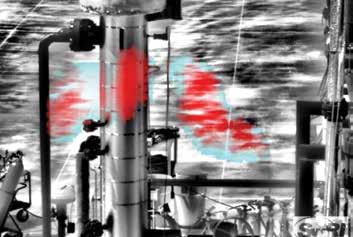
3 minute read
SLED Tackles New Challenges
SwRI engineers added two types of oil to tanks of water to train machine learning algorithms to detect oil under various lighting and environmental conditions.
SwRI is continuing to develop new applications for its Smart Leak Detection system (SLED), which autonomously finds liquid and gaseous leaks of hazardous materials. The award-winning SLED technology collects inputs from low-cost optical sensors and applies machine learning techniques to reliably detect the chemical “fingerprint” of methane gas escaping from pipelines as well as liquid leaks on solid surfaces such as soil, gravel, sand and now water.
QUANTIFYING METHANE LEAKS
SwRI is continuing the development of SLED/M technology to quantify fugitive methane emissions through a project funded by DOE’s Office of Fossil Energy and managed at the National Energy Technology Laboratory (NETL).
SwRI developed SLED/M to accurately detect small methane leaks that typically go unnoticed along natural gas pipelines and in compressor stations. Over the next year, SwRI will enhance the algorithms to quantify these leaks, adding a low-cost longwave infrared thermal imager and a lightweight lidar (light detection and ranging) system to the existing midwave infrared thermal imager. Natural gas leaks are typically measured from a single point using a diode laser absorption spectroscopy instrument, which must be moved to several positions to gather data.
“Conventional methods can be costly and time-consuming, and they often fail to pinpoint leak sources,” said Heath Spidle, SwRI project lead. “This new technology will enhance SLED/M’s proven methane detection algorithms with a physics model using 3D visuals to measure the volume of fugitive methane emissions.”
The DOE is particularly interested in developing scalable quantification technologies, partly in response to a recent Stanford study that found only one in nine methane detection technologies are reliable.
“This newly added task will continue the important research being done at SwRI,” said Joe Renk, the DOE NETL senior federal project manager overseeing the work. “The use of gas imagers and lidar with machine learning presents an opportunity to develop cost-effective solutions to accurately quantify natural gas flow rates.”
SLED/W FINDS OIL ON WATER
SwRI is using internal funding to expand SLED to find leaks on water. With over 80,000 miles of oil pipelines across the United States, many waterways are at risk for environmental damage from incidents such as the 2010 Kalamazoo Spill, which cost more than $1.2 billion and took three years to clean up. Monitoring waterways near oil pipelines is costly and time-consuming using conventional solutions that rely on satellite remote sensing or laser spectroscopy.

SwRI will quantify fugitive methane flow rates using machine learning, thermal imaging and lidar technology. A midwave infrared imager captured this methane plume (red and blue).
SwRI addresses these challenges with a SLED/Water system, which uses algorithms to process data from visual and thermal cameras affixed to aircraft, stationary devices or watercraft. This machine learning- based solution can detect and monitor oil leaks before they become major threats to lakes, rivers and coastal areas.
“SLED/W was able to detect two different types of oil with unique thermal and visible properties,” said Ryan McBee, who led the project. “SLED/W showed positive initial results, and with further data collection, the algorithm will handle more varied external conditions.”
SwRI applied a multidisciplinary approach to develop SLED/W. Computer scientists teamed with oil and gas experts from the Institute’s Mechanical Engineering Division to train algorithms to recognize the unique characteristics of oil on water. For example, oil can spread over water or blend with it, making it difficult for sensors to discern under various lighting and environmental conditions.
By combining thermal and visible cameras, SLED/W analyzes scenes from different perspectives. Visible cameras are limited by glare and have difficulty capturing transparent thin oils that blend with water. Thermal vision requires heat differences to discern features, which lead to false positives near animals and other warm objects. By combining thermal and visual images into the machine learning system, algorithms can choose the most relevant information, mitigating the weaknesses of each sensor.









